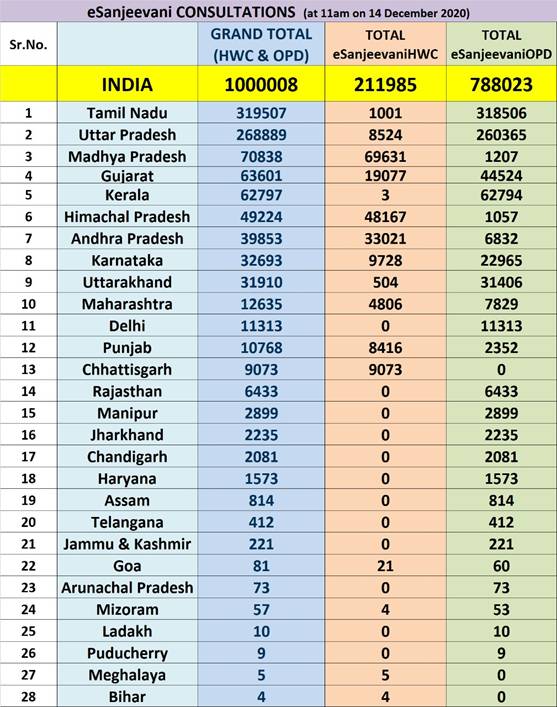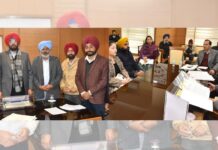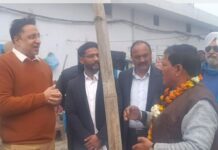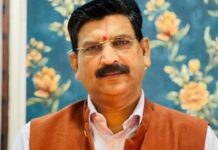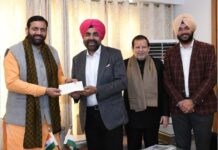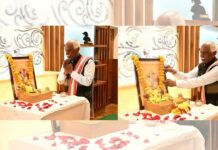“eSanjeevani” telemedicine service has 1 million teleconsultations
India has crossed a landmark milestone in its eHealth journey. eSanjeevani telemedicine service of the Health Ministry has crossed 1 million (10 lakh) teleconsultations. Telemedicine entails delivery of health services from a distance using internet and it not only extends the reach of health services but also betters the quality of health services and also saving time and money. The roll out of eSanjeevani in India is supposedly the first of its kind of digital transformation in the delivery of health services at national scale by a developing country. During the COVID-19 pandemic, eSanjeevani not only brought about a huge digital transformation in the delivery of health services but had also boosted the digital health ecosystem in the country.
eSanjeevani initiative of Health Ministry is serving in two streams in 28 States and Union Territories. The eSanjeevaniAB-HWC enables doctor to doctor teleconsultations and is being used at around 6000 Health and Wellness Centres which are being served by specialists and doctors in around 240 hubs which have been set up by States in District Hospitals or Medical Colleges etc. Over 20,000 paramedics, doctors and specialists have been trained to use eSanjeevaniAB-HWC. The second stream eSanjeevaniOPD is or giving remote health services to patients in the confines of their homes. eSanjeevaniOPD enables contactless, risk-free, and safe consultations between a doctor and a patient. It received a huge reception by both the patients and the doctors. Around 8000 doctors have been trained and onboarded on eSanjeevaniOPD and on an average around 1500 doctors practice telemedicine daily in around 225 onlineOPDs of which 190 are speciality OPDs and around 30 are general OPDs. Of late, daily eSanjeevani has been serving around 14,000 patients across the country.
eSanjeevani is being used by patients in over 550 districts of India. Over 10% of the users of eSanjeevani are aged 60 and above. Close to around one fourth of the total patients have used eSanjeevani more than once. These stands as a testimony to the fact that public has started preferring telemedicine over visiting hospital OPDs for consulting a doctor.
Considering the inherent potential and social impact of this emergent digital modality of delivery of health services, the States have designed innovative applications around eSanjeevaniOPD. In Kerala, eSanjeevaniOPD is is being used for providing health services to the inmates of Palakkad District Jail, in Himachal Pradesh too it is being rolled out in old age homes. Quick adoption of eSanjeevaniOPD services across the country has enabled launch of wide range of speciality and super-speciality OPDs including alternative medical systems such as AYUSH and naturopathy. Kerala has already setting up OPDs on eSanjeevaniOPD for providing services of Rashtriya Bal Swasthya Karyakram – District Early Intervention Centres for its populace. Each of these 14 onlineOPDs has a team comprising of psychologist, special educator, speech therapist and a physiotherapist who collectively look after common issues pertaining to child development and their future health.
The State Governments are complimenting the efforts of the Union Ministry of Health and Family Welfare, by establishing a robust digital health ecosystem comprising of IT savvy human and infrastructural resources to boost the adoption of eSanjeevani. The Health Informatics group of Centre for Development of Advanced Computing in Mohali is providing end-to-end technical services including development, implementation, operations, of eSanjeevaniOPD besides training clinicians. The Health Ministry in consultation with the States and C-DAC Mohali is consistently working towards enriching features and functionalities in eSanjeevani to help patients and doctors even more. The top ten States with highest consultations through eSanjeevani and eSanjeevaniOPD platforms are Tamil Nadu (319507), Uttar Pradesh (268889), Madhya Pradesh (70838), Gujarat (63601), Kerala (62797), Himachal Pradesh (49224), Andhra Pradesh (39853), Karnataka (32693), Uttarakhand (31910) and Maharashtra (12635).

 हिंदी
हिंदी
